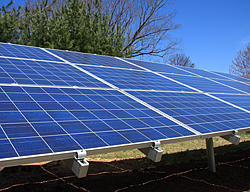Advanced Energy Technologies: Solar Energy and Storage

Challenge
The Administration calls for developing clean, alternative energy sources to mitigate global climate change, reduce dependence on foreign oil, strengthen the economy, and improve the environment. Solar energy is the most promising of the alternative energy sources. Yet, today's photovoltaic technologies are not up to the immense energy challenge that we face. New approaches are needed to support breakthroughs in the discovery and innovation of next-generation solar cell technologies as well as to enhance existing technologies.
Proposed NIST Program
Major advances in clean energy technologies require significantly increased understanding and control over complex systems at the nanometer scale, the almost infinitesimal domain from which solutions to many energy-related challenges are likely to emerge.1 However, technology developers lack the measurement tools with the requisite accuracy, precision, sensitivity, and temporal and spatial resolution. Under the proposed initiative, NIST will:
- Advance the measurement capabilities and prediction tools needed to 1) significantly increase the efficiency, reliability, and performance life of next-generation photovoltaic solar cells and 2) develop reliable, cost effective processes for manufacturing solar cells based on new materials and devices; and
- In future years, advance measurement methods to determine how nanoscale tailoring can increase the energy density, lifetime, charging rate, and overall performance of batteries and other advanced energy storage technologies.
Expected Impacts
Proposed research and development efforts will:
- Build the measurement infrastructures basic to understanding, characterizing, and developing efficient, inexpensive second and third-generation photovoltaic solar cells and devices; and
- Supply new data that will enable industry to accelerate development of manufacturing capabilities needed to make top-performing, cost-competitive next-generation photovoltaic solar cells and devices.
1National Nanotechnology Coordination Office and U.S. Department of Energy, Nanoscience Research for Energy Needs: Report of the March 2004 National Nanotechnology Initiative Grand Challenge Workshop

